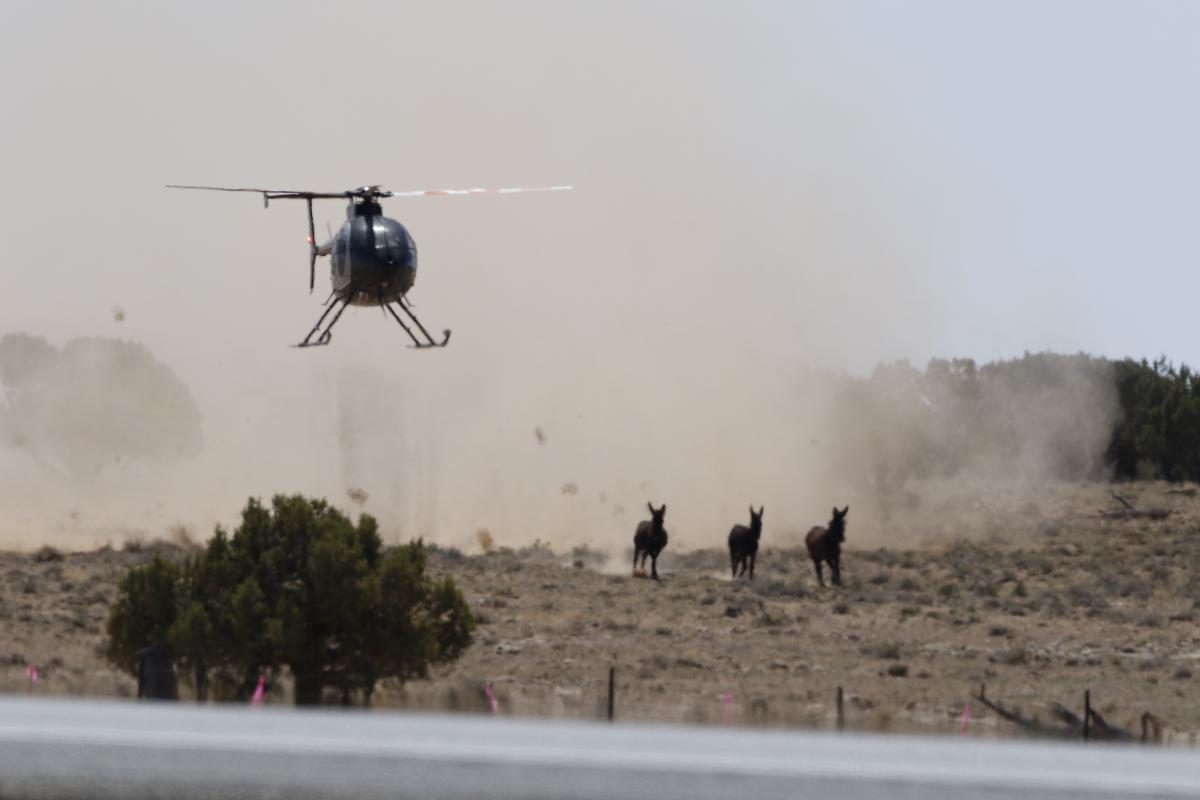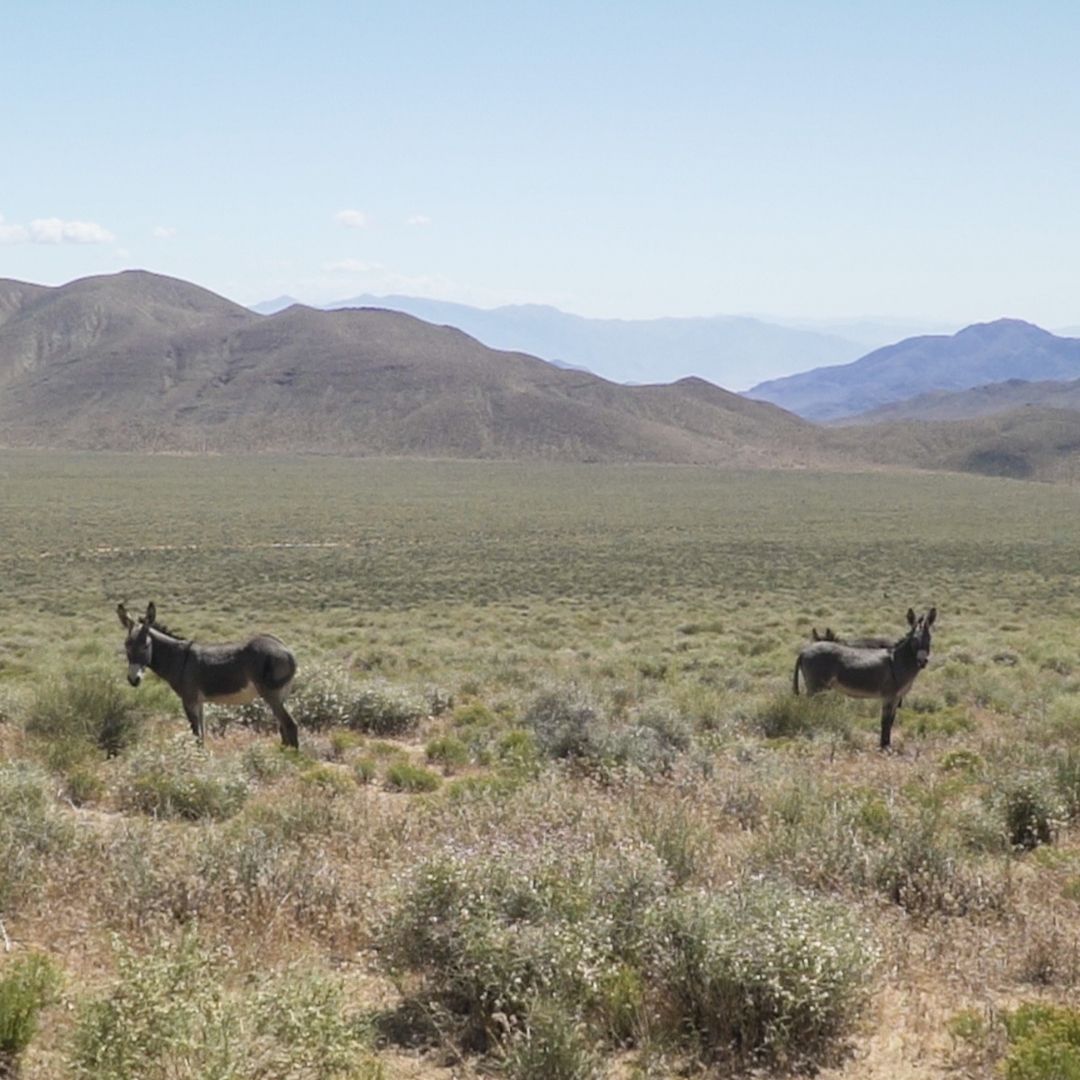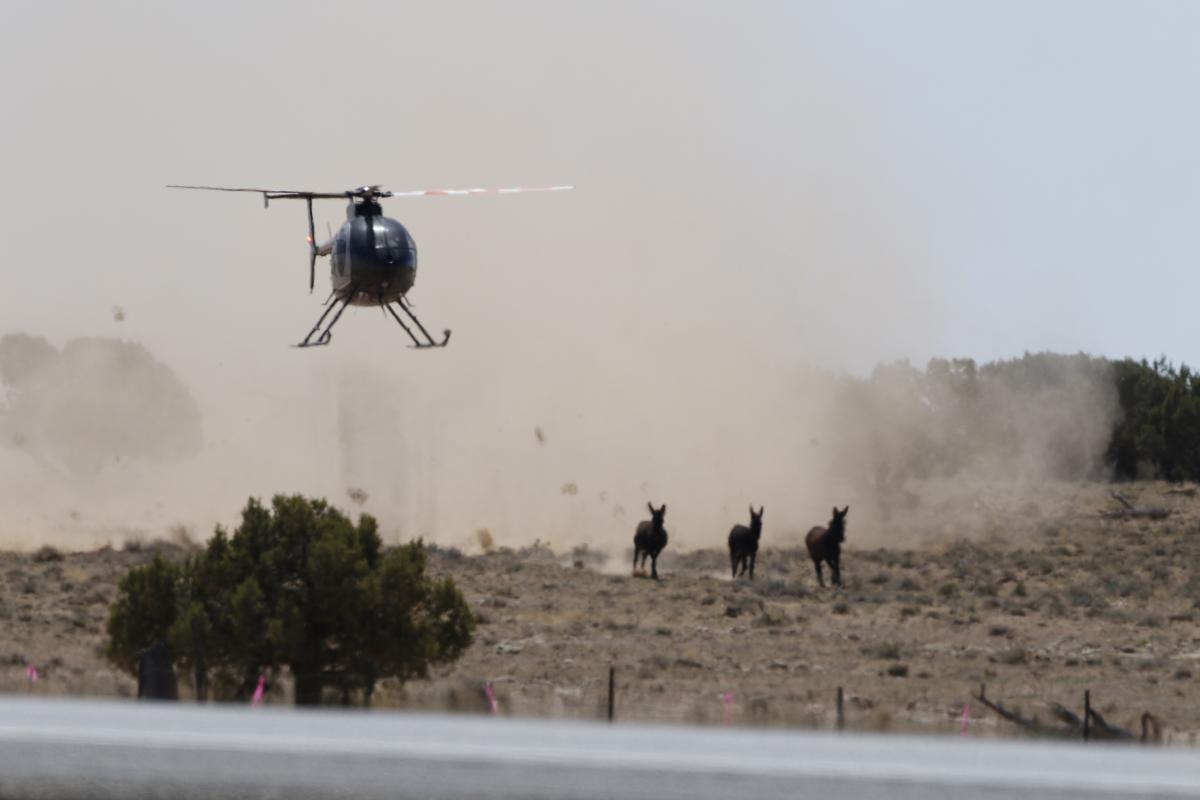By Laurie Ford, Volunteer Field Representative
(June 2, 2022) For years, the Bureau of Land Management (BLM) has acknowledged what little is known about the populations of wild burros they manage and that existing survey methods and analyses used to acquire data may not provide accurate and precise population size estimates.
 Despite this admission, along with recognizing the negative impact stress has on burros and that late spring and early summer are the peak of reproductive activity, the BLM has proceeded with one of the most aggressive helicopter roundup seasons of our wild burros with plans to remove 3,094 burros from 5 HMAs – including the Sinbad HMA – between April and August. One of their rationales; it is the BLM’s recent experience that almost all wild burros can be removed from the wild and placed into private care.
Despite this admission, along with recognizing the negative impact stress has on burros and that late spring and early summer are the peak of reproductive activity, the BLM has proceeded with one of the most aggressive helicopter roundup seasons of our wild burros with plans to remove 3,094 burros from 5 HMAs – including the Sinbad HMA – between April and August. One of their rationales; it is the BLM’s recent experience that almost all wild burros can be removed from the wild and placed into private care.
What makes this decision especially appalling is that valuable new information – data acquired at a cost of close to 11 million dollars and having the potential to provide a new ground zero in wild burro management - was on their doorstep.
Missed Opportunity
Step back for a moment to 2015 when the BLM, while discussing plans for a five-year study of burro demographics - to be carried out by the U.S. Geological Survey's Fort Collins Science Center and Colorado State University - admitted the study could provide a huge opportunity in future management decisions due to the current lack of data on wild burros.
Accurate data is crucial in managing our wild horses and burros by providing the foundation for all estimates that determine the numbers to be captured and removed. These numbers - obtained through on-ground and aerial survey counts, growth rate formulas and population models - are carried over from year to year and built into every environmental assessment and gather plan. A single error can have devastating consequences.
The 2013 National Academy of Science study, Using Science to Improve the BLM Wild Horse and Burro Program, found management decisions by the BLM were not based on science and the population estimates in HMAs were unsubstantiated. The NAS went on to state that the sequential counts of horse and burro populations on HMAs had substantial methodology flaws, were inconsistent, poorly documented, and seemed to be the product of hundreds of subjective, probably independent, judgments and assumptions by range managers and administrators about the proportion of animals counted during surveys, population growth rates, effects of management interventions, and potential animal movements between HMAs.
In 2016, a USGS study was integrated with a roundup of the Sinbad Wild Burro HMA and, in response to the NAS findings, that aimed to test new methods for counting burros.
After capturing 236 burros, DNA samples were taken and 103 returned to the range including 20 jennies fitted with timed release radio collars – somewhat resembling the yoke worn around a working animal’s neck – that were intended to fall off before the batteries expired in 5 years. The collars - also enabled with a remote release – would be removed during the next roundup in the case technology failed. Long-term collars had never previously been tested on wild burros yet the possibility of associated mortality was understood.
The data collected during the USGS study was also used to examine resource and habitat selection, breeding behavior and genealogy, and the social behavior and social groupings of burros. But, rather than applying these new findings the final determination for the 2022 roundups still relied upon, and incorporated, the same procedures and processes used to generate the national statistics and actual population-size surveys, which are the foundational data of all estimates that the NAS found to be “uncertain” and the study had been scrutinizing over the past 5 years.
The Roundups

Most of the roundups this year are being conducted by helicopters rather than the traditional and more humane methods for burros, bait and trap methods. Because burros tend to freeze in place or scatter when chased wranglers rope any burros that cannot be driven into the trap by the helicopter.
It has been well documented that the stress induced by roundups and capture puts burros at risk of dormant infections being re-activated, such as the herpes virus, which can be further complicated by secondary bacterial infections. The immune system of burros have already been compromised due to their fragmented habitat, reduced populations and diminishing gene pools leaving them even more susceptible to disease and infections.
During the 2016 Sinbad burro roundup, and shortly afterwards in holding facility, 25 burros died mysteriously - both an uncommon Asinine herpes virus and a chronic viral pneumonia were later identified as a potential cause. Five additional burros were also found dead on the range but the estimated time of their death was never disclosed. Was the death of the Sinbad burros the result of stress “waking up” these deadly dormant viruses?
Fast forward to May, 2022, 6 years after the USGS study commenced, as I observed the Sinbad wild burro roundup quickly go from a helicopter roundup to a roping event amid a multitude of helicopters, trucks and trailers, wranglers, BLM personnel and local law enforcement Simultaneously I watched a constant stream of campers, OHV vehicles and an array of visitors traverse, unhindered, across the same landscape the burros were blamed for “heavy utilization”.
The gather plan called to remove 278 – 300 in a later press release - of the estimated population of 328 and treat up to 20 jennies with Gonacon fertility control before returning them to the range. After 6 days, only 153 burros had been captured including 11 foals and 3 jennies still wearing the 2016 radio collars whose batteries had died long ago leaving 17 collared jennies still unaccounted for. There was one death when a burro pursued by a wrangler fell and injured his spinal cord requiring, he be euthanized.
Because they failed to reach the capture quota no jennies were treated with Gonocan – the fertility control which has never been used on wild burros before but can produce years of infertility in horses. If the BLM had succeeded in their original plan the Sinbad burros would have been put at a dangerously high risk of irreparable genetic damage.
 Reducing the herd to an AML of 50 – one burro per 2000 acres – would also have decreased the entire state of Utah’s burro population to around 171 – which, according to Dr. Gus Cothran, a leader in the field of equine population genetics, is barely over the number required to preserve genetic variability within a single herd.
Reducing the herd to an AML of 50 – one burro per 2000 acres – would also have decreased the entire state of Utah’s burro population to around 171 – which, according to Dr. Gus Cothran, a leader in the field of equine population genetics, is barely over the number required to preserve genetic variability within a single herd.
If the intention had always been to destroy the gene pool unique to the Sinbad burros – a herd the BLM never intended to manage as genetically isolated, unique, or separate from other wild burro herds - why was the genealogy of the Sinbad burros even included in the study?
Dr. Cothran stated that, “The Sinbad burro population had its greatest similarity with the Poitou donkey among the domestic breeds…It is unlikely that this breed has any direct relationship to the Sinbad population but is probably the type of donkey that Sinbad population is derived from.”
The Poitou, currently in threat of becoming endangered, is known for its size, large ears, and black or brown coat with a grey underbelly and white nose and eye rings. and no cross upon his shoulders or back. Many of these characteristics can be seen in the Sinbad burros who, while not having lengthy coats, also had the longer curly ear hairs like the Poitou.
As burro populations globally plummet due to the Ejio trade in China, the goal of the BLM is to reduce the national number of burros to 2900 while the rest of the world is trying to preserve their threatened populations. This number was determined prior to the conclusion of the USGS study - the study meant to provide a new “ground zero” in wild burro management which would have started with reevaluating AML.
In 2013, when the national wild burro population was 5842, the NAS report noted:
BLM "may need to assess whether the AMLs set for burros can sustain a genetically healthy total population." and that “removing burros permanently from the range could jeopardize the genetic health of the total population.”
The USGS study of resource and habitat selection had the potential to shed new light on BLM’s claims of overpopulation and heavy use by burros in areas of our public lands also populated with, and used by, humans, off-road vehicles and livestock. If the goal of the BLM is truly to obtain a thriving natural ecological balance, the impact on resources these other uses have must be considered along with new research validating the valuable contributions burros makes to the ecosystem such as their ability to create unique water sources by “digging” wells.
Finally, the release of a USGS behavior manuscript looking at the social behavior and social groupings of burros in the Sinbad HMA seems to be pointless after both have been almost destroyed as a result of the recent roundup.
The day after the Sinbad roundup ended, I decided to hike the area where the single burro’s death took place. I found the spot, but much to my horror I also found the dead burro. Seeing that little crumpled up brown body, with his Poitou white/gray belly and markings and curly ear hairs, I was devastated because I knew his death had been for nothing.
The BLM plans to return and trap the remaining mysterious “excess” Sinbad burros at a later date. That is, if they can find them.


